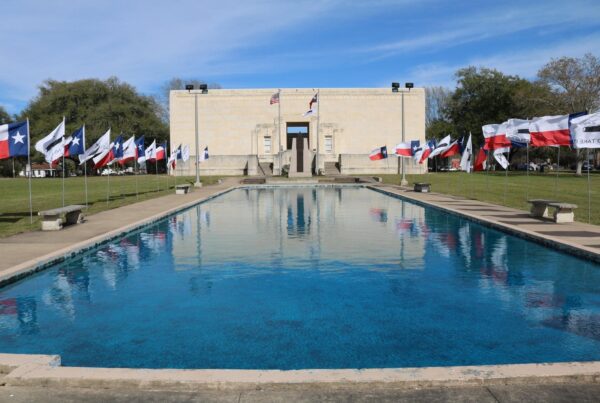Dr. John Curtis Jones was born in 1837 in Lawrence County, Alabama, the son of Tugnal and Susan King Jones who came to Texas in 1855 and settled near San Antonio. John began his study of medicine in Texas. He continued his education at the University of Edinburg, Scotland, and worked in Dublin, London and Paris before returning to Texas in 1861 to serve as surgeon for the Fourth Texas Regiment, Hood’s Brigade, CSA. Dr. Jones was personal physician to General J.B. Hood. The first hypodermic needle was brought to the Gonzales area by Dr. Jones in 1865. John married Mary Kennan Crisp May 23,1867. Mary, born February 19, 1847, in Holly Springs, Mississippi, was the daughter of Dr. Crisp and Mary Smith Crisp both of North Carolina. The Crisp family moved to Columbus, Texas, before the Civil War. After the Civil War, Dr. Crisp did not like the situation in Texas and moved his family to Brazil. Mary disliked Brazil and returned to the United States and eventually married John.
John and Mary built this wonderful Italiante style home in 1885. The L-shaped structure with wings only one room wide afforded maximum ventilation. A few years later an iron fence and brick walkway were installed and a carriage house was built on the eastern edge of the property. Cedar gutters carried rain-water through a charcoal filtering system and into an underground cistern. The exterior of the house is cypress siding with one piece extending vertically for the entire two stories. The floor beams are ten to twelve inches thick and rest on sandstone blocks. There are free-standing chimneys for the fireplaces. The house originally had a north wing and a large cupola. The cupola was destroyed in a storm in 1910 and the north wing was removed later. The focal point of the entry hall is a magnificent free-standing curved circular staircase made of Gonzales walnut. A large pine arch separates the entry hall from the formal parlor. The walls and wainscoting of the parlor are of prized curly pine paneling, three-quarter inch thick and grooved at a mill in Alabama or Florida. Altogether the house has seven different woods. They are pine, ash, red oak, white oak, maple, ebony and walnut. The materials were received at the port of Indianola, Texas, and carried by ox cart to Gonzales. The house was wired for electricity in the 1890’s and was reportedly the first house in Gonzales to have electricity and running water.
Dr. Jones died of diabetes January 25, 1904, and Mary died of pneumonia January 3, 1929. They are buried in the Gonzales Masonic Cemetery.












